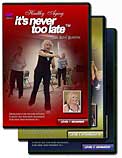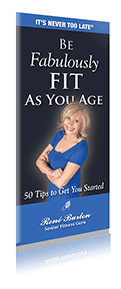 |
||||
|
CHAPTER ELEVEN - IT'S NEVER TOO LATE® Be Fabulously Fit as you age - by René Burton OSTEOPOROSIS and exercise Osteoporosis, which means porous bones, causes bones to become weak and brittle, so brittle that even mild stresses like bending over, lifting a vacuum or coughing can cause a fracture. In most cases, bones weaken when you have low levels of calcium, phosphorous and other minerals in your bones. Osteoporosis can also accompany endocrine disorders or result from excessive use of drugs, such as corticosteroids. In the United States, osteoporosis causes more than 1.5 million fractures every year. Usually these fractures occur in the spine, hip or wrist. About 8 million American women and 2 million American men have osteoporosis. As many as 18 million more have low bone density. The good news about osteoporosis is that It's Never Too Late® to do something about it. If you are a woman and haven't reached menopause, you can take measures to prevent osteoporosis from silently robbing your bones' strength. And if you are past menopause, tests can help detect the early stages of the disease. The strength of your bones depends on their mass and density. Bone density depends in part on the amount of calcium, phosphorus and other minerals bones contain. When your bones contain fewer minerals, their strength is decreased and they lose their internal supporting structure. Scientists have yet to learn all the reasons this occurs, but the process involves how bone is made. Bone is continuously changing. New bone is made and old bone is broken down, a process called remodeling or bone turnover.
A full cycle of bone remodeling takes about two to three months. When you are young your body makes new bone faster than it breaks down old bone, and your bone mass increases. You reach peak bone mass in your mid-thirties. After that bone remodeling continues, but the losses are greater than the gains by about 0.3 percent to 0.5 percent a year. Not getting enough vitamin D and calcium in your diet can accelerate the process. At menopause when estrogen levels drop, bone loss accelerates to about one percent to three percent a year. Around age 60, bone loss slows but doesn't stop. As women age, they may have lost between 35 percent and 50 percent of their bone mass. Men may have lost 20 percent to 35 percent. Your risk of developing osteoporosis depends on how much bone mass you attained between the ages 25 and 35 (peak bone mass) and how rapidly you lose it later. The higher your peak bone mass, the more bone you have "in the bank" and the less likely you'll be to develop osteoporosis as you lose bone during normal aging. 8 Risk Factors of Osteoporosis 1. Sex - Fractures from osteoporosis are about twice as common in women as in men. That's because women start out with lower bone mass and tend to live longer. They also experience a sudden drop in estrogen at menopause that accelerates bone loss. Slender, small-framed women are particularly at risk. Men, who have low levels of the male hormone, testosterone, are also at increased risk. 2. Age - The older you get the higher your risk of osteoporosis. As men live longer, their risk also increases. 3. Race - You are at greatest risk of osteoporosis if you are white or of Southeast Asian descent. Blacks have the lowest risk, and Hispanics and American Indians appear to have an intermediate risk. 4. Family History - Having a mother or sister with osteoporosis increases your risk. 5. Tobacco Use - The exact role tobacco plays in osteoporosis isn't clearly understood, but researchers do know that tobacco use contributes to weak bones. 6. Medications - Long-term use of corticosteroid medications, such as prednisone or cortisone is damaging to bone. These medications are common treatments for chronic conditions such as asthma, rheumatoid arthritis and psoriasis. 7. Sedentary lifestyle - Bone health begins in childhood. Studies have shown that children who are more physically active have the greatest bone density. Any weight-bearing exercise is beneficial, but jumping and hopping seem particularly helpful for creating bones. Exercise throughout life is important, and you can increase your bone density at any age. 8. Depression - recent studies show that women who experience depression have increased rates of bone loss. Osteoporosis is a major cause of disability in older women. get The powerful Answer to preventing Bone Loss and osteoporosis as you age... |
||||
BUY ALL 3 DVDS AND SAVE |
||||
FABULOUsLY FIT 139 page lifestyle BOOK |
||||
50 tips BOOKLET |
||||
|
||||
| Copyright © 2010 RB Fitness Enterprises, Inc. All rights reserved. Home | Privacy Policy | Contact Us | ||||
Rene Burton specializes in Senior Exercise Videos promoting Senior Fitness through exercise.



